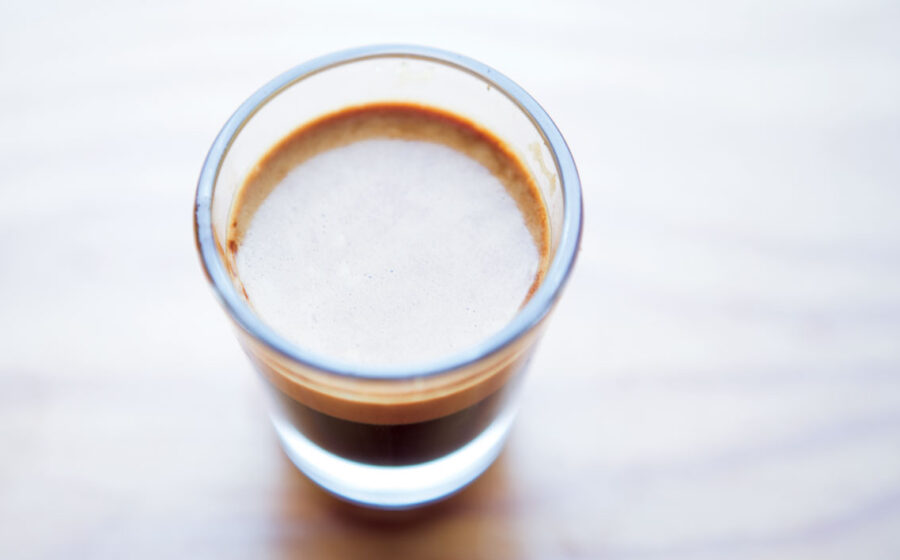[I] ordered two espressos, one for myself and one for my colleague who had joined me for an afternoon exploration of local espresso culture. We sat down at one of the whimsically mismatched tables, talked, and waited. The sounds of espresso being prepared filled the otherwise empty café space, and continued to for nearly ten minutes. Every minute or so, the barista would slurp his creation, pour out the remaining liquid, and start again.
This happened for so long that we wondered if any of the espressos would meet his standards. Eventually, two did, and we drank them. They weren’t particularly flavorful, which was a bit of surprise, given how many iterations they’d gone through before arriving in our demitasses.
I was left asking several questions as we sat there. Why did it take so long to dial in the espresso? Was it because we came in the afternoon, when business was light, and the barista hadn’t needed to make the regular adjustments that a more consistent flow of customers might have necessitated? Did the barista have the proper tools to make great espresso efficiently?
Am I really getting the most consistent espresso possible when I’m focusing on something as subjective and illusory as color?
Ultimately, while there is something easy and comforting about simply watching the color of the two streams of coffee pouring out of your portafilter’s spouts and then stopping the shot when they turn a translucent, creamy hue, as I wrote about last month, there’s also something inexact in this process that doesn’t comfort me at all. And that inexactness can lead to the kind of endless tweaking I saw in that empty café that cold afternoon last fall.
So the question I’m left to answer is this: am I really getting the most consistent espresso possible when I’m focusing on something as subjective and illusory as color? No, not really. So what am I to do? How can I ensure my customers are getting a great espresso every time, short of tasting them all before I hand them out (note: that is highly frowned upon)?
There are a couple tools that come into play here that can help your consistency tremendously. The first is a scale. The second is a volumetric (or “automatic”) espresso machine. These two tools can significantly improve the consistency of your espresso from shot to shot.
First, let’s look at the scale, and when we should use it.
In specialty coffee, we already advocate using a scale to weigh our dose of coffee and water when brewing coffee using pour-over methods, and so it is natural for that kind of commitment to accuracy to spread to other methods of coffee brewing as well. When it works within the flow of business, you should use a scale to ensure a consistent dose of ground coffee in your portafilter.
But what about using a scale on the other side of extraction, to weigh the output of that process? Consider the idea of placing a small scale under your shot glasses to assess the consistency of your final brew weight. With no context or frame of reference, the resulting number will be almost meaningless to you. Who can say what a forty-four-gram shot of espresso tastes like? No one, not without more information.
With some experimentation and note-taking, you can dial in your espresso quite nicely with a simple recipe—a recipe you developed with a scale.
However, with some experimentation and note-taking, you can dial in your espresso quite nicely with a simple recipe—a recipe you developed with a scale. You might find twenty grams of coffee in your portafilter—extracted for twenty-seven seconds to achieve a forty-six gram espresso—is the ideal way to experience the coffee you’re serving. And how repeatable is that? So repeatable.
If you’re not into the idea of using a scale on the exit end of your espresso, there is another way. Many espresso machines are volumetric (automatic), meaning they have several buttons, each of which can be programmed to brew with a specific dose of water. While not as minutely accurate as a scale, these are still an excellent way of removing one variable from the process to allow you to focus on dialing in elsewhere.
For instance, let’s say you know you want a two-ounce double espresso. With one of the buttons on your machine programmed to exactly two ounces, you can adjust your grind and dose to meet your expectations of flavor with the final brew volume already set. It’s one more way to set up a recipe for your espresso that allows the best possible flavors to shine through while simultaneously eliminating the eternal dial-in that can plague shops and baristas who don’t have the same structure built into their process.
There are many ways to arrive at the result we all want: excellent espresso, prepared efficiently. For some, planning every step along the way, including exact gram weights and timing, is the best method to get there. For others, feeling it out as they go, assessing every shot by color, is their preferred manner.
Whatever you choose to do, be consistent! Your business may depend on it.
—Nathanael May is director of coffee for Portland Roasting Coffee.
















